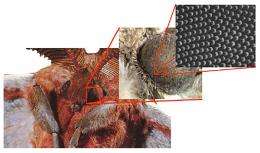The corneal surface of many insects is structured with a subwavelength grating of protrusions believed to provide wide bandwidth antireflective properties.
(PhysOrg.com) -- If you look closely at the surface of a moth's cornea, you see that it is comprised of tiny protruding bumps. These bumps exist to keep moths safe from predators by preventing light from reflecting in their eyes and betraying their presence. In essence, the moth's eyes are naturally antireflective.
Antireflective (AR) surfaces are commonly used to prevent glare in optics -- think of the thin film coating applied to then lens of your favorite glasses.
In a unique application, Mark Mirotznik, associate professor in the Department of Electrical and Computer Engineering at the University of Delaware, has adapted these AR ideas and applied them to materials at microwave frequencies.
Advances in passive imaging at millimeter wave frequencies have created a need for high quality optical components, such as lenses, designed specifically for these wavelength bands, explains Mirotznik.
Broadband AR surfaces are commonly implemented by coating the surface with multiple layers of thin films, with the exact number and thickness of layers needed determined by various optimization algorithms.
The approach is tricky when using microwave and millimeter wavelengths, however, because suitable materials are scarce and signal strength is commonly many orders of magnitude smaller than that encountered in the visible or infrared wavelengths.
Inspired by the subwavelength surface pattern of the cornea in common insects, Mirotznik has developed an inverse motheye surface that is easier to fabricate than traditional motheye surfaces, more mechanically robust and provides good AR behavior.
The main application for this research is to create radio frequency (RF) transparent windows, most likely using composite materials, for use in military applications.
“We've demonstrated that it is possible to use a moth eye approach to create special surfaces in which microwave energy is transmitted with very little reflections over large ranges of frequency or bandwidths,” he says.
“Expensive antenna systems can then be placed behind the structural windows, safe from the outside environment, or in the case of military applications, from hazards such as gun fire or explosives.”
Mirotznik's research is documented in a paper entitled “Broadband Antireflective Properties of Inverse Motheye Surfaces.” The paper, which appeared in the IEEE journal Transactions on Antennas and Propagation, recently earned Mirotznik the 2011 H.A. Wheeler Prize Paper award. The H. A. Wheeler Prize is presented to authors of the best applications paper published in the IEEE Transactions on Antennas and Propagation during the previous year.
Co-authors for the paper include UD doctoral student Brandon L. Good, one of two researchers at Carderock Division of the Naval Surface Warfare Center; and two researchers from the U.S. Army Research Laboratory.
Provided by University of Delaware






















